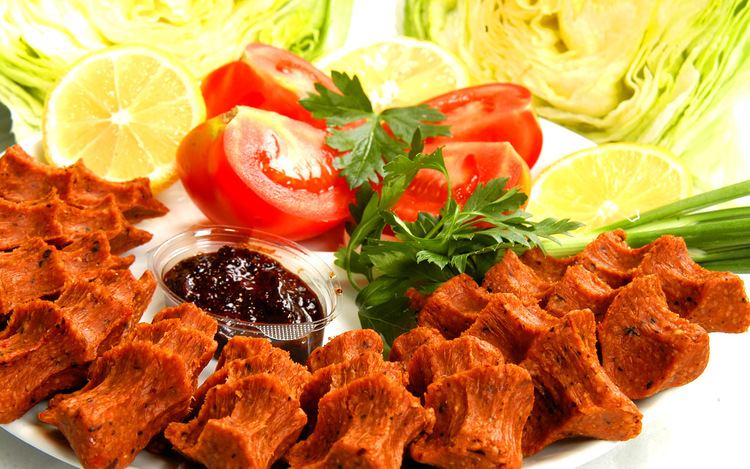Ingredients generally used Mentha, spice, lemon | ||
 | ||
Main ingredients Bulgur, Onion, Tomato paste, Urfa biber, Table salt Similar Kofta, Lahmajoun, Bulgur, Kibbeh, Dürüm | ||
Istanbul street food raw meatball wrap i k fte turkey street food
Raw meatball ([ˌtʃiː cʰøfˈte])is a raw meatball dish. In Armenian, Kurdish, and Turkish cuisine, very similar to kibbeh nayyeh and to a lesser extent to steak tartare. It is traditionally made with either beef or lamb, and usually served as an appetizer or meze.
Contents
- Istanbul street food raw meatball wrap i k fte turkey street food
- Meat differences
- Armenia
- Turkey
- References
Meat differences
In the beef variant, ground beef is used. Tendons and fat are removed before grinding the beef. Relatively expensive high-quality beef has to be used so that the meat can be safely served raw. London broil or top round are recommended choices for the ground beef.
Since lamb is considered a "clean meat", it is often used for çiğ köfte instead of beef. Both Armenians and Turks use çiğ köfte as a meze, served almost cold. The raw meatball, or kofta, is not kept overnight and is reserved for special occasions. The lamb used must be deboned, degristled, and trimmed before it is prepared. The lamb is supposed to be butchered, bought, and prepared the very same day to ensure freshness. With either meat, finely ground bulgur (durum and other wheat) is required. Other ingredients are mild onions, scallions, parsley, and usually green pepper. Variants of the dish may use tomato sauce, Tabasco sauce, and mint leaves. When served, it may be gathered into balls, or in one piece. Crackers or pita bread are sometimes used to consume it.
Armenia
"Chi" in Armenian means "No or not," and "chepouadz kufte" means not cooked kufte. Chi Kofte is considered a delicacy in Cilician Armenian culture and is normally prepared on special occasions, especially during holidays. There are many varieties of chi kofte among Armenian families depending on the historic region they are from and their personal preferences. For example, some may use more or less bulgur, and some may use more or less pepper paste depending on their desired spiciness.
Traditional Armenian chi kofte is made in two varieties, either in loose meatball form in the shape of a small egg, or flattened on a plate with olive oil and minced green onions, similar to kibbeh nayyeh. However, unlike Levantine Arabs, eating chi kofte with bread is not common among Armenians.
A vegetarian variety also exists which is shaped very similarly to chi kofte and with a similar texture. Although it is prepared throughout the year, it is particularly popular during Lent in accordance with the diet restrictions of the Armenian Apostolic Church.
Chi kofte was introduced in the United States by Armenian immigrants, and was commonly referred to as Armenian steak tartare. This term is not as common today based on the declining popularity of steak tartare.
Turkey
In Turkish, çiğ means "raw" and köfte means meatball. It can also be written as one word, çiğköfte. It is a favorite Turkish snack and a specialty of southeastern Turkey, especially Şanlıurfa and Adıyaman.
Bulgur is kneaded with chopped onions and water until it gets soft. Then tomato and pepper paste, spices and very finely ground beef are added. This absolutely fatless raw mincemeat is treated with spices while kneading the mixture, which is said to "cook" the meat. Lastly, green onions, fresh mint and parsley are mixed in. Some çiğ köfte makers, particularly in Adıyaman, do not use water in their recipes. Instead of water, they use ice cubes and lemons.
One spice that is associated with çiğ köfte, and with Şanlıurfa as a whole, is isot, a very dark, almost blackish paprika, prepared in a special manner, and which is considered as indispensable for an authentically local preparation of çiğ köfte.
A favorite way of eating çiğ köfte is rolled in a lettuce leaf, accompanied with good quantities of ayran to counter-act the burning sensation that this very spicy food will give.
Although traditional recipe requires minced -raw- meat, the version in Turkey consumed as fast-food (through small franchise shops in every neighborhood of Turkey) must be meatless by law due to hygienic necessities. Therefore, çiğ köfte is, unless restaurant or home-made, vegan in Turkey. Meat is replaced by ground walnuts, hazelnuts and potato.
